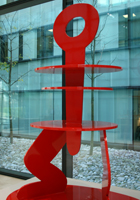
Ahead of World AIDS Day 2008, two sculptures by Keith Haring have come to UNAIDS to join the “Art for AIDS” collection. Credit: UNAIDS
Ahead of World AIDS Day 2008, two sculptures by Keith Haring have come to UNAIDS to join the “Art for AIDS” collection. His iconic and poignant work has been instrumental in raising awareness around AIDS issues worldwide.
The UNAIDS headquarters building in Geneva received on Wednesday two new additions to its “ART for AIDS” collection. The artworks are two sculptures by the celebrated artist and AIDS activist Keith Haring which have been loaned to UNAIDS by the Keith Haring Foundation.
In his all-too-brief lifetime, Keith Haring (1958-1990) produced artwork at a prodigious rate and reached a worldwide audience that transcended differences of race, nationality, gender, age, and sexual orientation. He used his now iconic symbols— the barking dog, radiant baby, dancing person and the heart—to encourage reflection on and dialogue about social and political issues.
The humanist elements of his work allowed him to communicate on virtually universal terms. As a result, Haring used his designs for many public and social awareness campaigns, including AIDS prevention, literacy, UNICEF children's causes, and the fight against South African apartheid.

Haring enlisted his imagery during the last years of his life to generate activism and awareness about AIDS. Credit: UNAIDS
Haring was diagnosed with HIV in 1988. In 1989, he established the Keith Haring Foundation, whose mandate is to provide funding and imagery to AIDS organizations and children’s programmes, and to expand the audience for Haring’s work through exhibitions, publications and the licensing of his images. Haring enlisted his imagery during the last years of his life to speak about his own illness and generate activism and awareness about AIDS.
Although his art had always reflected his social consciousness, in Haring's last years many of his works were devoted to creating cultural awareness about HIV and gay rights issues.
The UNAIDS’ Art for AIDS is an art collection created to recognize the role art has played in the response to AIDS. The pieces in the collection have been chosen to provoke thought and dialogue around some of the most difficult issues around AIDS. With an initial emphasis on contemporary African art, the collection has grown to more than 60 museum quality pieces thanks to the involvement of artists, collectors and donors around the world.





